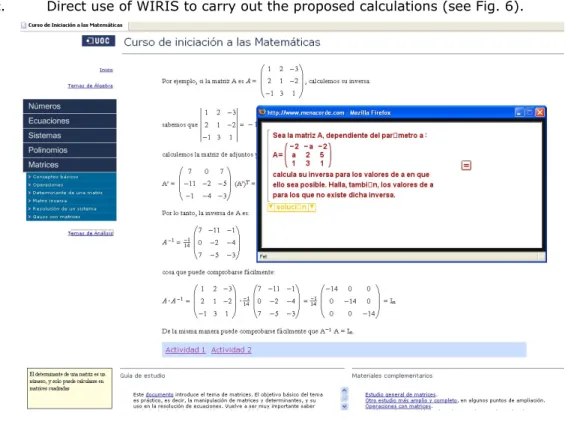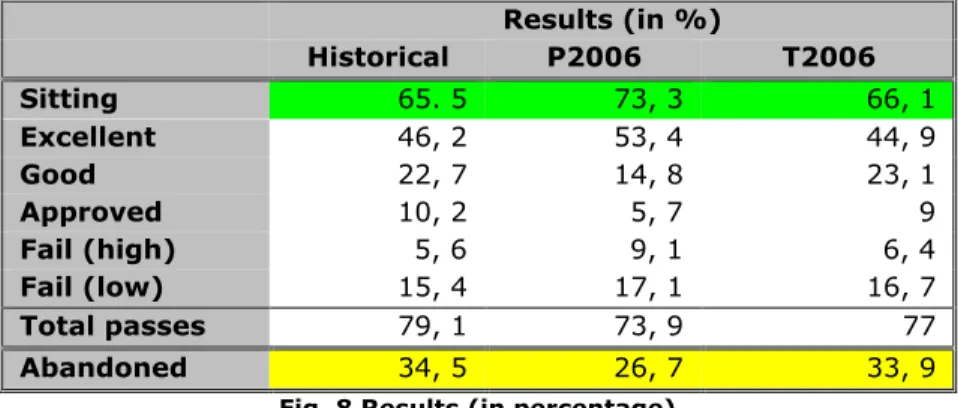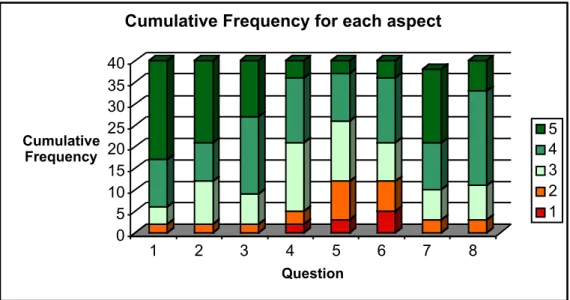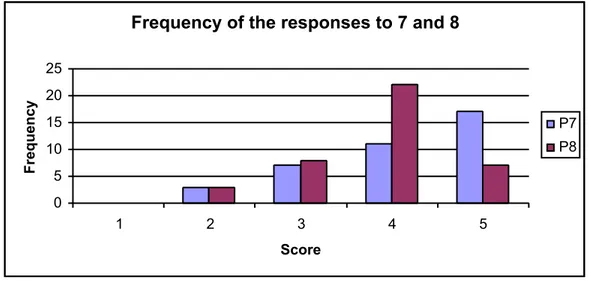A virtual learning environment for pregraduate mathematical students
Texto completo
(2) The engineering courses offered by the UOC include IT Engineering (3-year IT Management Degree, 3year IT Systems Degree and 5-year Engineering Degree), and Telecommunications Engineering (Telematics). The academic results of the different programmes show that the teaching and learning process is not easy - particularly in mathematics: students' prior knowledge is often insufficient, they find the content hard to grasp, and their level of motivation is low. We have to make an effort to mitigate these factors and guarantee that students can eventually reach the level of knowledge required to successfully carry out their professional activities. Mathematics in engineering courses One of the main aspects that should be taken into account when designing an engineering course is students' prior level of knowledge. In particular, the syllabi of all engineering courses, particularly those of telecommunications courses, include many subjects that require an understanding of mathematical concepts and processes. The basic mathematics subjects in these syllabi cover the fundamentals of linear algebra and differential calculus and provide the tools required to solve simple differential equations. The telecommunications engineering course introduces the basic complex variable tools required to understand and handle the Fourier Transform, Discrete Fourier Transform and z Transform. It also covers the tools required to analyse non-deterministic phenomena: random variables and stochastic processes. IT engineering courses study basic statistical techniques and introduce discrete mathematics as the basis for many of the processes studied, from the analysis of information structures and the efficiency of their use to the construction of circuits. A basic understanding of mathematics is required to study these subjects, as well as to achieve the objectives in other technical or physical areas, especially during first-year courses. In particular, students should have a basic grasp of the different types of numbers, be able to solve equations and linear equation systems, handle polynomials and have a clear understanding of functions and differential and integral calculus. To help students assess their level of knowledge and their awareness of how to apply this knowledge, before they register for a course, we recommend they complete a series of exercises with the help of a brief guide. Specifically, we provide a summary of the concepts and basic processes in each topic. Students can use books and their own notes when taking these tests; the aim is to make them aware of their level of mathematics, so they can decide whether they ought to go over this area again before registering for the mathematics subjects in the course. We also give them the solutions to the exercises, so they can see if they have managed to solve them correctly and see the procedure for a correct answer. They also receive guidelines for interpreting their. 2.
(3) results. They should take two key factors into account when assessing their level of knowledge: whether they have mastered the techniques required to solve the exercises, and, if not, whether they have understood the given solution. After evaluating their results with the help of a tutor, students can decide whether to register for the subjects in the first semester or whether it would be advisable to revise before doing so. In this case, we recommend they register for the Introduction to Mathematics for Engineers course. Shown below are the basic characteristics of the course, the proposal for innovation, the learning environment developed, and the results of the pilot tests. Characteristics of the course to Introduction to Mathematics for Engineers As mentioned above, mastering mathematics is vital, both in terms of content and methodology, in order to study any scientific course. Therefore, we aim to ensure that students have the necessary preparation for the course; otherwise, they may have problems passing some of the main course subjects. The Introduction to Mathematics for Engineers course has a twofold objective: students should learn the fundamental terminology, techniques and concepts of Algebra and Mathematical Analysis, and should be able to apply this knowledge in practical cases. Specifically, the objectives of the subject are the following:. •. Understand basic set theory and, in particular, the theory of number sets. •. Handle polynomials, and solve equations and inequations. •. Handle matrices, calculate small matrix determinants, and solve linear equation systems with two and three variables through the Gauss method. •. Understand the concept of real functions with real variables and the characteristics of the main families of functions. •. Understand the concept of a limit, understand its properties and calculate limits by applying the main calculus rules. •. Understand the concept of a derivative and its geometrical representation and properties, and be able to calculate derivatives by applying calculus rules. •. Use integrals, defined as a tool for the calculation of areas. 3.
(4) •. Apply these concepts to analyse practical cases. All in all, the main aim of the course is to prepare students to follow engineering courses with the mathematical knowledge and skills required. The course methodology follows the UOC's pedagogical model in using didactic materials, teaching activities and continuous assessment as its main pillars (Duart 2000). The work dynamic is based on guided study of the different topics, and carrying out the set activities. The assessment system involves completing exercises that are handed in to the teacher on given dates established at the beginning of the year (Continuous Assessment Tests). These exercises are then corrected and discussed to ensure students advance during the learning process. Students communicate with teachers by posing a series of questions to them, preferably through the Classroom Forum (since this enriches classroom dynamics and creates an optimal learning environment). The Forum is a reference space which can be used to send queries, comments and suggestions; communication between students and teachers improves the learning process for a subject which might not initially be very interesting and which students might find hard to cope with. Students can also communicate with teachers by sending a private message to their personal mailbox. This method is normally used by students who think that their queries might not necessarily be of interest to other students. Many times, when the teacher and student agree, the comments or queries are posted on the forum to strengthen group dynamics. Teaching innovation proposal: Objectives Our eight-year experience in this subject has led us to start a teaching innovation process in the mathematics area of engineering courses. The main aim of the innovation project is to design and develop a virtual environment that facilitates the learning process of basic mathematical content for future UOC engineering students. A series of specific goals has been established to achieve this aim:. •. establish a new pedagogical model based on the existing model. •. design a virtual environment to teach basic pre-university mathematics content. •. establish the final proposal for the Introduction to Mathematics for Engineers course. •. create content. •. develop the first version of the environment. 4.
(5) •. test the environment during the first semester of the 2006-2007 course. •. analyse the results obtained, students' satisfaction and the teacher's assessment of the course. •. establish a set of upgrades that need to be implemented and any new elements to be developed. Evolution of the existing pedagogical model The first step of the innovation process involves outlining the existing pedagogical model and clearly identifying its elements and evolution capacity. The main pillars of the model, which is studentfocused, are the didactic materials, teaching activities and continuous assessment, but we should also take into account a series of complementary elements that place the student and learning process within the framework of a university institution: the virtual library, support centres and social relations. Even though it is important to have a global vision, our approach to the problem is based on a learning process for a specific topic in the classroom. We say that the three basic elements of the model are the student, the teacher and the content. Traditionally, content would concentrate on a textbook which students would have to assimilate and understand with the help of the teacher to carry out the activities required for the subject. This traditional distance-learning situation works regardless of the format of the study materials and the communications channel between students and teachers (see Fig. 1). However, at the UOC, communication is established through the Virtual Campus and materials may have a digital format, with the possibility of introducing a number of changes both in the model and in the learning process.. STUDENT. Post Telephone. STUDY MATERIAL. Books. Classroom sessions Internet. Paper notes /pdf Videos Interactive Applications. TEACHER. Fig. 1 Distance-learning model layout. 5.
(6) Evidently, the presence of computer networks has revolutionised the educational environment (Romiszowski, 1997), particularly in distance university learning. Effectively, these networks allow all those involved in the process to communicate and share materials, which can be stored and distributed in digital format, but the main objective is that students can build their own conceptual networks and, in one word, learn. At the UOC, the virtual classroom is organised into four independent sections: planning, communications, resources and assessment. The planning section has a teaching plan and calendar for the term, where the key dates of the course are set out; the communications section can be used to access the notice board and forum, as well as the list of students with their respective email addresses; the resources section includes the materials for the subject; and the assessment section contains all the information related to the assessment process. From our point of view and taking into account the fact that most students are adults with a series of family and professional responsibilities, it is vital to integrate all elements of the learning process. Therefore, we make use of information and communication technologies to create a learning environment for a specific subject which incorporate content, teacher guidelines and communication between students and teachers (see Fig. 2).. STUDENT. ICT. STUDY MATERIAL + STUDY MATERIAL. TEACHER. Fig. 2 Innovative proposal. 6.
(7) Study materials: A new learning space The second step of the innovation process involves the design and development of study materials that integrate the contents of basic pre-university mathematics, indications for correct follow-up of this content and recommendations for finding appropriate support and complementary materials. The addition of communication between students and teachers on specific matters is part of the future lines explained in the last section of this article. The final characteristics of the material have been designed taking into account teachers' experience with the old material, students' opinions and knowledge of the evolution of information and communication technologies in recent years as well as their educational applications (Hill et al., 2001). The conceptual principles that led us to establish the guidelines for these characteristics are shown below. 1.. All resources should be integrated within a single learning environment. Students should find all materials for the course, whenever required, in a single environment. Teachers' experience shows that few students use the resources offered separately from the main materials and that these materials are not always used appropriately.. 2.. The material should cover the needs of all students on the course, some of whom have a very low level of mathematics, although others are more prepared. To ensure it can be adapted as far as possible to each and every student, it should contain very basic contents and be sufficiently flexible.. 3.. The materials should meet a twofold objective: specific material for a course and, at the same time, reference material which can be used at any time.. 4.. Even when the material has been designed for the Introduction to Mathematics for Engineers course, it has been prepared as an archive of basic mathematical knowledge. In any case, both functions should be clearly distinguished in the study environment so as not to confuse students.. 4.. The following content characteristics should be taken into account in relation to the format of the material: materials should be offered as PDF files when the web format does not offer any added value, so students can print a high-quality copy of the material. The web format should be reserved for contents that include interactive exercises, Java applications or Flash sequences. All in all, the purpose is to make the learning process more flexible and interesting, finding a balance between traditional material that can be printed and material on the web.. 7.
(8) 5.. In addition to the previous point, we should say that all the components of the material should comprise a unit that is clearly recognised by the student, both in terms of the content and the study sequence proposed. We should avoid the use of resources which - although they may be very good quality in themselves - are not required or are not the most appropriate resources for inclusion within the course teaching plan.. Evidently, the evolution of the information technology and communication concepts, as well as the constant update of the main Internet applications has been a determining factor in the establishment of content format and delivery. Therefore, the following basic principles have been taken into account: 1.. Universality: The applications should run under Windows, Linux or Mac, and with the standard browsers, Explorer and Firefox. In addition, and whenever appropriate, future changes in environments or browsers should not render the applications obsolete.. 2.. Usability: The applications included should not require additional explanations for their use, which should be clear enough for everyone. The use of the WIRIS calculator in some exercises is an exceptional case, since it has been adopted by the UOC as a basic tool for all mathematics subjects in engineering courses and students should therefore be familiar with it.. 3.. Online and local operation: The material should be installed in a server for online access, but it can also be installed in the student's PC.. Following these guidelines, a first version of the materials has been launched, which is currently in the testing phase. As regards its content, we simply have to solve some misprints and perhaps include a series of minor modifications to implement improvements in the level of interactivity and resources for the concepts and procedures which students have most problems with. In addition, to improve the user's graphical interface, we should take into account the opinions of teachers and students on the level of usability. To choose the best form of storing information has been one of the most important difficulties in the implementation of the learning environment. Fortunately, research activity in making mathematics computation accessible on the Web and Internet has increased considerably (Wang, 2004). Finally, the materials have been written following the MathML 2. 0 standard (http://www.w3.org/Math/) in xml documents.. 8.
(9) This allows us to comply with the universality principle; all materials can be viewed from any of the most common browsers. If you use Firefox or Netscape, you should install the specific fonts that can be downloaded from the Firefox website. If you use Internet Explorer, you should install the free MathPlayer plug-in in your WindowsOS to view correctly the formula written in MathML. Other free resources that should be installed to view correctly all elements included in the material, regardless of the Operating System and browser:. •. Java software, used to run applets. Most of the applets of the material have been developed using GeoGebra (http://www.geogebra.at/cms/), a software designed by Markus Hohenwarter (who gave us some recommendations on its optimal performance himself), mainly used for the development of interactive geometrical sequences and which has been used in our case to view the properties of functions.. •. Macromedia Flash Player (http://www.macromedia.com/software/flash/about/), to view applications developed with Flash.. •. Acrobat Reader, to view PDF documents.. •. In addition, students should install the WIRIS calculator in their computers if they do not have a DSL Internet connection. We also recommend a good Internet connection to facilitate access to interesting links, although it is not vital.. Finally, the Hot Potatoes software has been used to design html pages with complex multiple-choice questions, self-correcting crosswords and other types of interactive questionnaires. Description of the environment The space for the study material on the screen is divided into five different areas with different functionalities (see Fig. 3).. 9.
(10) 2. 1. 3. 4. 5. Fig. 3 Screenshot of one of the pages of the material. 1.. Central space, where the contents are presented, showing examples and activities. The characteristics of the course favour a fully atomised organisation of concept and procedures that enables short, clear and concise presentations. There are always one or two examples and the activities required to ensure that the contents are understood. Various different resources are used and they depend on the characteristics of what the student is working on. For example, procedures are explained with sequences programmed in Flash that simulate the teacher writing on the blackboard; some concepts are presented with an interactive explanation that allows you to change parameters and modify the settings. There are three types of activities: a.. Multiple-choice, which can be used by students to check they have completed the exercise correctly and receive some hints (see Fig. 4).. 10.
(11) Fig. 4 Self-assessment test. b.. Solution provided by the student, checking the results with a detailed explanation that can be displayed (see Fig. 5).. Fig. 5 Detailed solution of an exercise. 11.
(12) c.. Direct use of WIRIS to carry out the proposed calculations (see Fig. 6).. Fig. 6 Exercise with the WIRIS calculator. Solution of an activity by handling determined parameters of an interactive application. The detailed solution is also available next (see Fig. 7).. Fig. 7 Interactive application. 12.
(13) 2.. A space reserved for the general menu, with three drop-down sections which can be selected by clicking on the name. •. Home: contains the description of the key points that should be taken into account before starting the study of the contents of the course. 3.. •. Algebra topics: contains a drop-down menu with all basic algebra contents. •. Topics for analysis: contains a drop-down menu with the basic contents for analysis This includes short news items on punctual issues and important matters which have already been addressed. The purpose of this space is to give students the opportunity to refresh the contents already studied in the form of a brief sentence.. 4.. The study guide includes the guidelines required to start each topic: specific guidelines will be provided about the work rate, giving the previous content that should be analysed before starting the topic, and providing the corresponding explanations and the depth to which the concept should be assimilated.. 5.. This space includes the reference to complementary support and extension materials, which are not required to follow the course but will be very useful for anyone who has problems following the course, as well as others who voluntarily wish to expand their knowledge on the course content.. Pilot test Students' first contact with the materials was during the Autumn semester of 2006 (A2006). Some students had problems with the installation of the interactive material (mainly the use of Flash and Java); however, these problems were solved during the first few weeks of the course. In addition, some misprints were spotted in the content of the materials during the semester which were immediately corrected in the forum. These are the results of the subject (A2006), together with the results of the previous semester (S2006) and the results of the subject since its start (1, 339 students).. 1. 1. :. The percentage for each grade and passed exams is calculated over the number of people who have followed the course. 13.
(14) Results (in %) P2006. Historical Sitting Excellent Good Approved Fail (high) Fail (low) Total passes Abandoned. 65. 46, 22, 10, 5, 15, 79,. 5 2 7 2 6 4 1. 34, 5. 73, 53, 14, 5, 9, 17, 73,. T2006. 3 4 8 7 1 1 9. 66, 1 44, 9 23, 1 9 6, 4 16, 7 77. 26, 7. 33, 9. Fig. 8 Results (in percentage). We can see that the percentage of students that followed the course is lower during this semester (66.1%) than the previous semester (63.6%), but slightly higher than the historical value (65.6%). Among those students who have followed the course, the rate of passes is more or less constant between 75%-80% and it seems that during the semester S2006, the grades were better than those in the historical data (we can say that the students were better prepared than we expected) with more people having followed the course, while during semester T2006 the historical values were very similar. To analyse the influence of the material on the results, some of the questions made during the A2006 Continuous Assessment Tests (CATs) were identical (or very similar) to the previous semester. After analysing them one by one, we can conclude that, in general:. •. There has been a slight improvement (less than 1%) in the results in the Algebra block with the same answers. •. In the Analysis block, there has been a slight worsening (approximately 4%) in the results of the same answers. We should analyse the factors that may have an impact on this difference in results between both parts and whether they can be related to the different tools used in each one or not (more interactive in the case of the Analysis). A questionnaire was given at the end of the year to all students (answers were received from 40 of the 119 students registered) to find out more about their opinion on the different aspects related to the material. They were asked to give a score between 1 and 5. The aspects questioned were the following:. 14.
(15) 1.. Easy to use. 2.. Easy to browse. 3.. Contents are properly arranged. 4.. Explanations are clear and complete. 5.. Explanations of the material are sufficient to complete the activities set out. 6.. Activities are sufficient to assimilate the contents and carry out the CATs. 7.. Usefulness of complementary materials. 8.. Giving a global score to the material. This is the cumulative frequency diagram for each aspect:. Cumulative Frequency for each aspect 40 35 30 25 Cumulative Frequency 20 15 10 5 0. 5 4 3 2 1 1. 2. 3. 4. 5. 6. 7. 8. Question Fig. 9 Cumulative Frequency Diagram. We should highlight that only questions 4, 5 and 6 have obtained a score of 1 and, in general, there are very few scores under 3. More specifically:. •. The aspects related to the usability are rated with an average of above 4. •. Most scores for aspect 4 (the explanations are clear and complete) range between 3 and 4. •. The aspects related to the activities and exercises obtain slightly lower and less concentrated scores, although only 10 of the 40 score under 3. •. Complementary materials are rated between 4 and 5 by most people questioned. 15.
(16) •. Finally, in most questionnaires the global score of the material (aspect 8) is 4, with only two opinions scoring under 3.. The frequency of the responses to the last two aspects are given in Figure 10:. Frequency of the responses to 7 and 8. Frequency. 25 20 15. P7. 10. P8. 5 0 1. 2. 3. 4. 5. Score Fig. 10 Frequency of the responses to the 7 and 8 aspects. Another aspect included in the questionnaire is the number of technical problems during installation and use of the material. In general, the responses to this aspect indicate that there has been a low level of problems with the installation and use of the material. In addition, these problems have had a low impact on the study: 4 out of the 40 people surveyed said that their studies have been quite or very negatively affected by these problems. Therefore, we can state that most students are quite satisfied or very satisfied with the features of the material, except for the activities and list of activities with an evaluation process, having a slightly lower score. Finally, we can summarise of all this information and add some of the comments of the students questioned. These are the following matters that should be addressed to improve the material: Correcting misprints, since the number is higher than that expected due to the fact that it is new material. This will be almost completely solved for the next semester. Conclusions and future lines of action The first version of an environment used to learn basic mathematics at university has been designed, developed and tested.. 16.
(17) From our experience we want to point out three relevant aspects: 1.. The need of use effective and expressive mark-up elements to represent and structure mathematics education pages that may also contain XHTML and MathML elements in order to have reusable learning objects. 2.. The convenience of in-depth mathematics education for adults in order to analyse the factors that may have an impact on results of different contents. That is, we should assess the suitability of the learning tools used in different types of content for future UOC engineering students. 3.. The material does not seem to have had a positive or negative effect on the results. In any case, and given that it seems that the group of people who have followed the course during the P2006 semester were better prepared, we cannot conclude that the influence of the new material is negative in the assimilation of concepts. In fact, it should rather be the other way round.. More specifically, the online environment developed should evolve in different directions. On the one hand, the graphical interface with the user should be analysed in order to improve the use of images and graphical objects that present the information and facilitate the lines of action available. On the other hand, the way in which the communication between students and teachers on existing materials is integrated should be defined. During the first phase, different possibilities have been studied to add comments about a specific question, either privately or shared, with the purpose of customising the material and sharing doubts, observations and comments. Finally, we should check the assessment system and decide upon the most adequate technology that should be implemented for this system. Therefore, we should take into account that its general purpose is a threefold educational action: as a follow-up and learning improvement tool, as an accreditation system for the student's learning level and as an instrument used to redesign the educational approach to the subject. We believe that if we design a specific proposal for the mathematics subject, we will not only have a way to guarantee that students have achieved the set objectives, but we will also ensure that they have the stimuli required to carry out the activities required throughout the learning process.. 17.
(18) References Duart, J. M. & Sangrà, A. (2000). Formación universitaria por medio de la web: un modelo integrador para el aprendizaje superior. In: Duart, J. M. & Sangrà A. (Eds.), Aprender en la virtualidad (pp. 171-188). Barcelona: Gedisa. Hill, J. & Hannafin, M. (2001). Teaching and Learning in digital environments: The resurgence of resource-based learning. Educational Technology Research and Development, 49 (3), 37-52. Romiszowski, A. (1997). Web-Based Distance Learning and Teaching: Revolutionary Invention or Reaction to Necessity? In: Khan, B. (Eds.), Web-Based Instruction (pp. 24-40). Educational Technology Publications, CA: Englewood Cliffs. Wang, P. S., Zhou, Y., Zou, X.. (2004). Web-based mathematics education: MeML design and implementation. In: Proceedings of the International Conference on Information Technology: Coding and Computing (ITCC’04). 1, 169175.. 18.
(19)
Figure
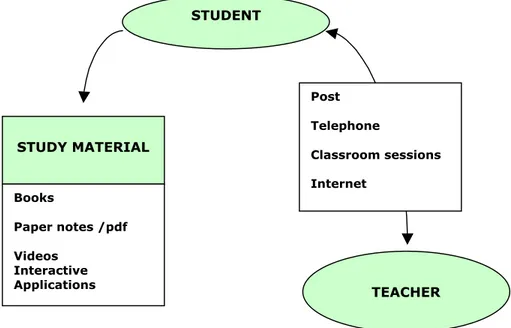
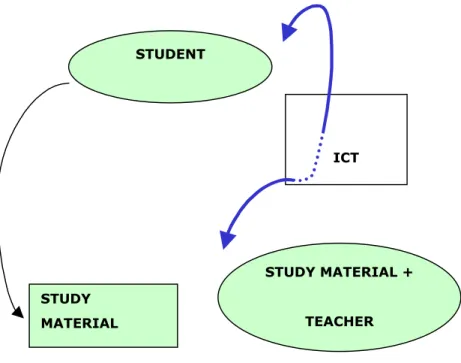
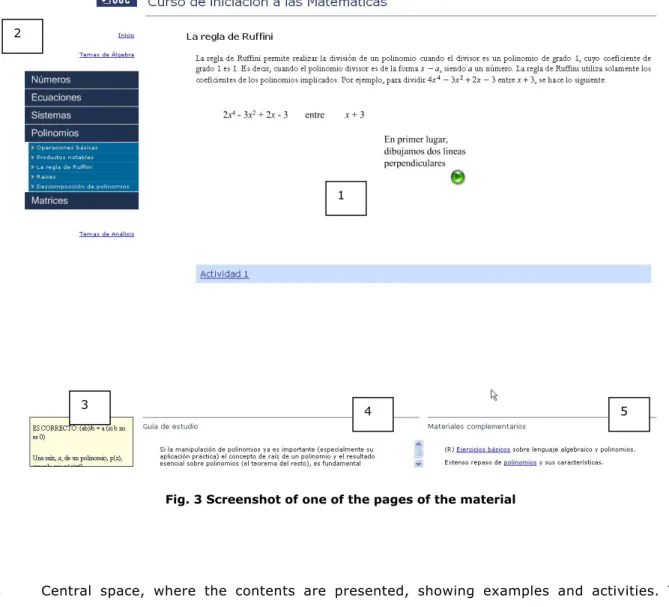
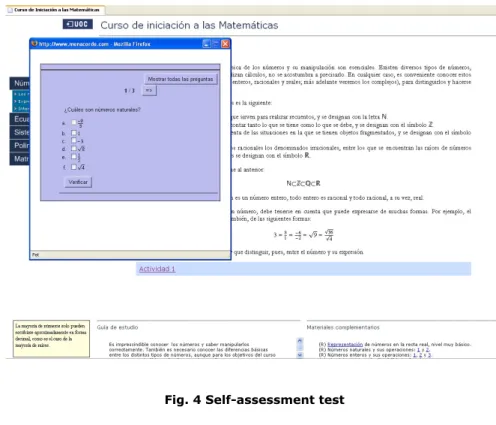
Documento similar
In the preparation of this report, the Venice Commission has relied on the comments of its rapporteurs; its recently adopted Report on Respect for Democracy, Human Rights and the Rule
We seek to characterize the transport in a time-dependent flow by identifying coherent structures in phase space, in particular, hyperbolic points and the associated unstable and
No obstante, como esta enfermedad afecta a cada persona de manera diferente, no todas las opciones de cuidado y tratamiento pueden ser apropiadas para cada individuo.. La forma
The development of digital competencies of both teachers and students contributes to the adoption of new technologies that sup- port the learning process (Blau et al., 2020;
"Fouling Out the American Pastoral: Rereading Philip Roth's The Great American Novel." Upon Further Review: Sports in American Literature.. Michael Cocchiarale and
As regards to the influence of reuse activities within the company, those companies analyzed in this field consider that this activity has supposed the opening and maintaining
In the previous sections we have shown how astronomical alignments and solar hierophanies – with a common interest in the solstices − were substantiated in the
What is perhaps most striking from a historical point of view is the university’s lengthy history as an exclusively male community.. The question of gender obviously has a major role
